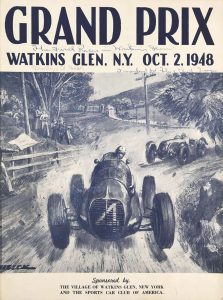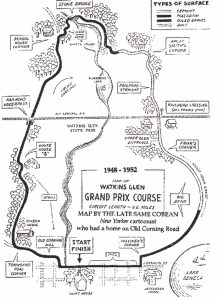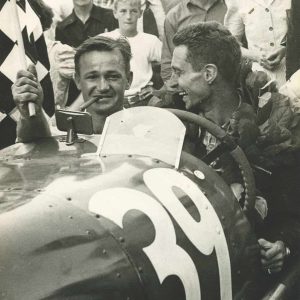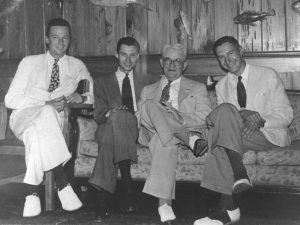Event Program: 2025 Mission Foods Watkins Glen SpeedTour
The Founders
Barron Gift Collier and The Collier Brothers by Rich Taylor
Our saga starts with Barron Gift Collier, a larger-than-life, self-made entrepreneur from the Gilded Age. Born in 1873 in Memphis, Barron was the son of U.S. Naval officer Cowles Myles Collier, who resigned his commission to join the Confederacy in 1861. Cowles’ reputation and fortune both blew up when the Confederate gunpowder mill he commanded was destroyed.
With no money nor connections, Barron Collier dropped out of school at age 16 and went to work for the Illinois Central Railroad. At 20, he became a salesman for a Memphis printing company that made advertising posters placed in horse-drawn street cars. Inspired, Collier promptly moved to New York City and started the Consolidated Street Railway Advertising Company.
Almost overnight, his in-house agency was preparing advertisements that he placed in street cars, buses and subway trains for thousands of clients from New York to San Francisco, Chicago to Havana. By the time he was 26, Collier was already worth a million dollars. J.P. Morgan became his personal investment advisor, William Randolph Hearst and Theodore Roosevelt his friends.
In 1907, Collier married much younger Juliet Gordon Carnes of Memphis. Four years later, Barron and Juliet stayed at the Florida vacation home of John Roach, a wealthy client who ran the Chicago Street Railway Company. They liked Roach’s place so much, Barron and Juliet bought all of remote Useppa Island, including Roach’s house, for $100,000. It’s now the exclusive Collier Inn, a National Historic Site.
At the time, Collier was raking in $5-million a year, and already had Overlook Estate on the Hudson River adjacent to John D. Rockefeller’s Kykuit in Sleepy Hollow, NY, a summer house in Presque Isle, ME and Villa Meineck in Baden-Baden, Germany. He and Juliet travelled by private railroad car or on one of his yachts.
Collier constantly expanded and diversified his business, buying or starting two different chains of hotels, a chain of banks, a telephone company, the Atlantic Coast Steamship Company, a group of golf courses, the Manhattan bus company and a long-distance bus company that became part of Trailways. He also became a patron of the Boy Scouts of America, founded in 1910.
Most importantly, Barron Collier was one of the business leaders who guided and bankrolled the Golden Era of Transportation that blossomed between 1900 and 1940. In addition to his promotion of railroads, street cars, subways, buses and airlines, he encouraged Americans to vacation by automobile, and through his political connections was responsible for thousands of miles of new roads.
During the post-World War I Recession of 1921-1923, despite J.P. Morgan warning him not to waste his money, Collier bought 1.3-million acres of undeveloped land in Southwest Florida. He personally paid millions of dollars to complete the 368 mile Tamiami Trail from Tampa to Miami via Naples.
The Miami to Naples stretch of the Tamiami Trail aka “Alligator Alley” was a gargantuan task that took years to finish, but in the process required the invention of new road-building machinery and techniques that spread throughout the world. In 1923, parts of Lee County were split off into two new counties named for the largest landowner in each: developer Barron G. Collier and Francis A. Hendry, Cattle King of Florida.
Collier then spent the next 15 years developing not just Collier County, but Florida’s entire Gulf Coast. He was responsible for roads, canals, railroads, bus lines, steamship lines, banks, phone companies, hotels, restaurants, airports, real estate sales…a total infrastructure carved out of tropical jungle and aimed at bringing residents and tourists to beaches from Sarasota to Naples.
His income was rumored to be $10-million a year during the Roaring Twenties, and he spent most of that transforming Collier County. He suffered stock market losses in 1929, but still had more than enough to keep wheeling and dealing through the Thirties. Barron Gift Collier had a lasting impact on transportation and tourist industries not just in Florida, not just in America, but around the globe.
Still working 12 hour days, he became ill at his beloved winter home on Useppa Island, was brought back to New York and died March 13, 1939 at Manhattan Medical Center. He never knew that in 1943, oil would be discovered in what is now called Sunniland Oil Field in the middle of Collier County, and that Collier Resources would help turn his heirs into not just millionaires, but multi-billionaires.
Collier Brothers
Barron and Juliet Collier had three sons. Barron Collier Jr. was born in 1908, Samuel Carnes Collier in 1912 and Cowles Miles Collier in 1914. All three enjoyed the classic upbringing of rich men’s sons between the World Wars; horses, boats, airplanes, golf, guns, girls, St. Paul’s, Yale and then a job in the family firm. More importantly for our story, the three Collier brothers were raised around fast cars. Indeed, Barron Jr. once reported riding in their Auburn boat-tailed Speedster while his father averaged 100 mph down Alligator Alley!
In 1930, together with a neighbor, Thomas Wheeler Dewart, whose family owned the New York Sun newspaper, the teenage Collier brothers designed a primitive race course using the driveway and service roads of their Overlook Estate, which added up to .75 miles. They grandly labeled this Sleepy Hollow Ring.
To start with, they persuaded the family chauffeurs, led by Clifford Couzzins, to build a group of what we would now call go-karts, powered by engines taken from lawnmowers and small motorcycles. The fastest was Sam’s racer, powered by a Henderson Inline-4. It was rumored to accelerate rapidly to 35 mph, but overheat the moment it reached 40!
Things quickly became much more serious. Barron Jr.’s girlfriend presented him with an MG J-2 when they got engaged. This was one of the first MGs in America. Sam acquired a 1932 Auburn 12-160 V-12 Speedster. The impromptu races now created so much dust, Barron Sr. had the whole Sleepy Hollow Ring paved. This was probably the first purpose-built, paved road course in North America!
The next year, the young Collier brothers, along with equally-upscale Briggs Cunningham, George Rand and Charles Moran, incorporated the elite Automobile Racing Club of America. They convinced a young advertising illustrator who worked for the Collier Agency to design the ARCA logo and newsletter. Thanks to their connections, ARCA artist William Mitchell joined Harley Earl’s General Motors Art & Color Section in 1935, eventually retiring 42 years later as the legendary GM Vice-President of Design!
Between 1933 and 1941, ARCA organized “round-the-houses” races at not only Sleepy Hollow Ring, but on a 3.3 mile course in nearby Briarcliff Manor, at Marston’s Mill on Cape Cod, Montauk on Long Island, Alexandria Bay on the St. Lawrence River, Memphis on the Mississippi and in 1940, around the exhibition buildings of the Flushing Meadows World’s Fair. The also raced up Mount Washington Auto Road. Many drivers who became famous racers in the Fifties got their start in ARCA events.
It was fashionable among these wealthy young racers to give their cars cutesy names. Among the famous ARCA cars that still survive today are “Ardent Alligator,” “Bu-Merc,” “Leonidis,” “Old Grey Mare” and “Scrambling Eggs!” All these cars are home-built hot-rods, combining engine, chassis and body parts from disparate machines.
These ARCA cars are the true ancestors of not only Briggs Cunningham’s Le Mans racers and Carroll Shelby’s Cobras, but literally hundreds of American road racing “specials” like Ambro, Devin, Kellison and Victress that were the backbone of SCCA for decades and are still a major component of SVRA vintage grids.
In 1934, Sam and Miles went to Europe. They cut a deal with Cecil Kimber of MG that made them the MG agents for the United States. Their pal George Rand, who had been at St. Paul’s with them, had graduated from Harvard then opened a foreign car dealership in Manhattan. He became their exclusive MG dealer.
While they were in England, Sam and Miles picked up a Riley Brooklands and an MG Magna. The next year, Sam and George Rand went to Europe, where they raced Briggs Cunningham’s MG K-3 Magnette in Ireland and bought for Miles a special supercharged MG PA, one of three built for Le Mans. 
Once back in the States, Miles had the PA rebodied by John Oliveau with gorgeous aerodynamic aluminum bodywork. Miles named it “Leonidis,” after the leader of the 300 Spartans who held the Pass at Thermopylae against the Persians in 480 BC. Miles and Leonidis won every race they entered in 1938. In 1939 Leonidis returned to Le Mans, driven by Miles and Lewis Welch for less than 4 hours before the fuel tank split. Leonidis is now one of the gems of Miles’ son Miles C. Collier’s REVS Institute.
The last ARCA race was in 1940, at the World’s Fair. Miles drove Briggs Cunningham’s new “Bu-Merc,” a Buick Century chassis with 5.3-liter Inline-8 clothed with a simple body and the grille from a wrecked Mercedes SSK. He ran Second behind Frank Griswold’s Alfa-Romeo 308 GP car until crashing the Bu-Merc when the brakes failed with just 3 laps to go. Sam Collier finished fifth in an MG.
All three Collier brothers were trained pilots, and served as officers throughout World War II. Barron Jr. worked his way up through the ranks, finishing as a Major on General Douglas MacArthur’s staff. Sam Collier was a Navy pilot. Miles spoke fluent French, so ended up in the Office of Strategic Services, clandestinely dropping into Occupied France to work with the Resistance.
In 1944, as World War II was winding down, a group of ARCA members, including the Collier brothers, George Rand, Charles Moran and Briggs Cunningham, incorporated a successor to ARCA, which they called the Sports Car Club of America. Their plan was to start running European-style road races on public roads, much like their ARCA events.
Immediately after the War, all three Collier brothers and their families moved to Palm Beach, where Briggs Cunningham also had a home. Barron Jr. took over Collier Corporation, sold the New York based advertising business and concentrated on Collier County. He stopped racing and ran the family business until he died in 1976.
It was 1948 before modern American racing really began with the SCCA-sanctioned Watkins Glen Grand Prix on October 2, 1948. Cornell law student Cameron Argetsinger convinced quaint Watkins Glen, NY to let him put on a race over 6.6 miles of village streets and country roads. The last ARCA race in 1940 had been won by Frank Griswold driving an Alfa-Romeo GP car. The first SCCA race in 1948 was won by Frank Griswold in a different pre-war Alfa-Romeo, an 8C-2900. Briggs Cunningham’s Bu-Merc challenged Griswold both times, driven by Miles Collier in 1940 and Briggs himself in 1948.
Miles Collier actively raced a variety of cars both before the war with ARCA and after the war with SCCA, especially his famous “Ardent Alligator.” This was the old Brooklands Riley Nine he’d owned for years, repowered with a hot-rod Mercury V-8.
How quick was the combination of Miles Collier and Ardent Alligator? Well, they won the 1949 Watkins Glen event ahead of Briggs Cunningham’s Ferrari 166 Spyder #016-1, the first Ferrari race car in the U.S. which had begun its career by winning a 12 Hour race at Montlhery in 1948, driven by Luigi Chinetti/Lord Selsdon!
In 1950, Miles shared Cunningham’s famous Cadillac Coupe de Ville “Petit Pataud” with his brother Sam, finishing tenth Overall, Second in Class at Le Mans behind the Cadillac V-8 Allard J2 of Sydney Allard and Tom Cole but ahead of Briggs and Phil Walters in “Le Monstre.”
In failing health, Miles Collier raced at Sebring in 1953, sharing a D. B. Panhard 750 with famed writer/photographer Bernard Cahier and at Sebring in 1954 in a Bandini, under the nom de course of John Marshall because he had promised his mother, Isabel Uppercu, that he would give up racing after his brother Sam was killed. Cowles Miles Collier died of an infection diagnosed as polio in April, 1954.
Sam Collier was the most enthusiastic of the Collier brothers. He was pals with George Rand, and the sparkplug who put together the long-time deal with MG. He raced a variety of MGs with ARCA, including finishing fifth Overall, First in Class in the final 1940 ARCA event at Flushing Meadows.
After the War, he finished fourth in the first Watkins Glen Grand Prix in 1948, then drove his supercharged MG TC to Third Overall at the Bridgehampton road races in June, 1949. At Watkins Glen in 1949, on Saturday, Sam was Third in his MG behind George Weaver in a Maserati R1 and Briggs Cunningham in the famous Ferrari 166 Spyder. 
By Bridgehampton in June, 1950, Sam had talked Briggs Cunningham into letting him drive the Ferrari. He finished Second both Saturday and Sunday. At Watkins Glen, Sam raced the Cunningham Ferrari again. On Sunday, September 23, 1950, Sam Collier started on the fifth row of the grid, but was leading by Lap 2. He then inexplicably crashed on the fastest section of the original Watkins Glen course, and was thrown from the Ferrari. He died at 6:30 pm in the hospital at Montour Falls.
Roughly 2.5 miles from the Start/Finish Line in front of the old courthouse, the Collier Monument—a huge granite boulder—wears a bronze plaque that reads, “Samuel Carnes Collier 1912-1950 crashed here while leading the Grand Prix 1950. Miles Collier 1914-1954 Winner Grand Prix 1949.”
The very first race at Sebring, an SCCA 6 hour on New Years Eve between 1950 and 1951, was held just 3 months after Sam had been killed. It was called the Sam Collier Memorial Sebring Grand Prix. In 1954, after Miles died, the SCCA initiated an annual Collier Brothers Memorial Trophy Race for MGs. Gus Ehrman won the first year, with his MG TD Mk II.
Over the decades, people forgot the significance of the Colliers, so in 1985, Miles C. Collier convinced SVRA to hold an all-MG Collier Cup each year at Watkins Glen. After all, not only were Barron Jr., Sam and Miles Collier the MG importers for decades and major race winners in MG cars, they started ARCA, started SCCA and thanks to their father, Barron Collier, inherited a gigantic international conglomerate that continues to be a major influence on the American transportation system, even today.
Then there’s Miles Collier’s son Miles C. Collier. A racing driver, restorer, collector, automotive writer and owner of the second-largest car collection in the United States, Miles C. Collier is one of the most important “car guys” in the world. He deserves a Founders article all of his own!


